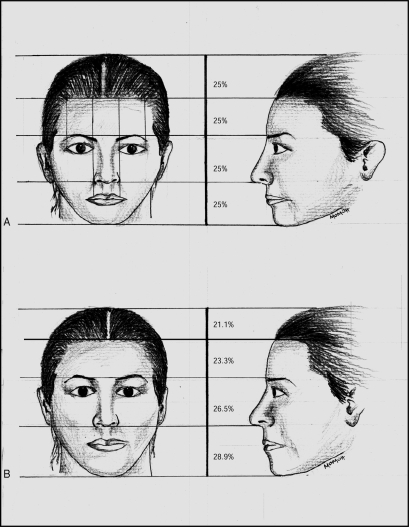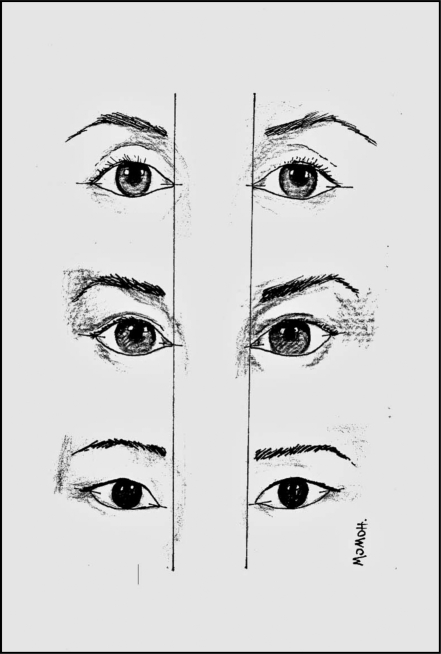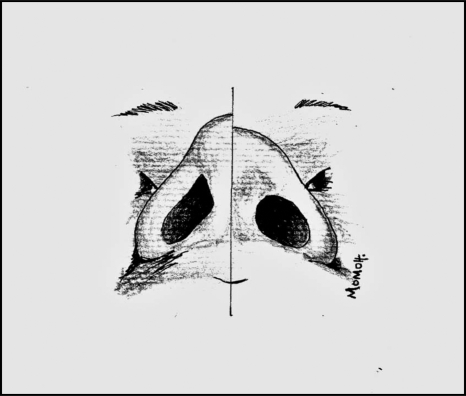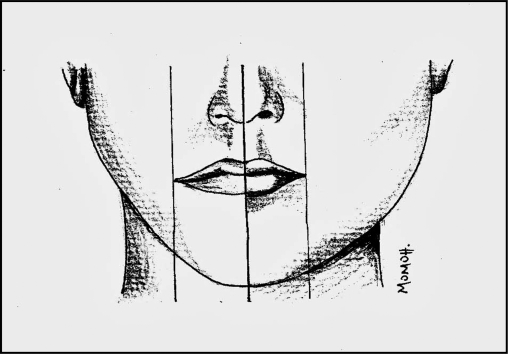ABSTRACT
Analysis of the differences in facial morphology and skin structure and tone among ethnic groups within the realm of plastic surgery is relevant due to the increasing number of ethnic individuals seeking cosmetic surgery. Previous classifications of ideal facial morphologic characteristics have been revised and challenged over the years to accurately reflect the differences in facial structure that are aesthetically pleasing to individuals of differing ethnic groups. The traditional neoclassic canons reflected the European Caucasian facial morphology and cannot be used to classify facial characteristics in ethnic groups due to drastic differences in measurement and proportion. In addition, differences in biophysiologic properties of ethnic skin types influence the progression of aging and the ability of skin to withstand environmental insults. Thickness of the stratum corneum, water content, and melanin composition are important factors that were analyzed in varying ethnic groups. Although it appears that Caucasian Americans are subject to earlier onset of skin wrinkling and sagging than are African Americans due to thinner stratum corneum layers and decreased water content, more research needs to be conducted to be inclusive of other ethnic groups. These data will enable plastic surgeons to treat these groups more effectively while preserving their unique characteristics.
Keywords: Ethnic, differences, facial morphology, skin structure, cosmetic surgery, plastic surgery
Cultural customs, traditions, dress, and geography are several factors that distinguish ethnic groups across the world. However, the most obvious difference between individuals of varying ethnic groups is physical appearance. From the neck down to the toes, we are all very similar; however, it is the facial structure and skin tone that most noticeably differentiates one ethnic group from another.
FACIAL STRUCTURE
The neoclassic canons of facial morphology have traditionally been based on the European Caucasian facial morphology/structure. These canons have set the standards of beauty that the rest of the world is compared with within the discipline of plastic surgery. Unfortunately, if an ethnic individual is to attempt to conform to these standards of beauty, he or she risks obscuring or completely obliterating his or her ethnic identity. As many in the plastic surgery world have noticed, this poses a problem when consulting clients of varying ethnic backgrounds on facial plastic surgery options when they desire to preserve their original ethnic features.
The neoclassic canons classify facial morphology by measuring vertical and horizontal parameters. Canons 1 through 4 represent vertically oriented facial parameters, whereas 5 through 8 represent horizontal parameters. The parameters of angle of inclination are represented by canon 9.
The combined head-face height is divided into 2 equal parts.
The combined forehead-face height is divided into 3 equal parts.
The combined head-face height is divided into 4 equal parts.
The length of the nose equals the length of the ear.
Interocular distance equals nasal width.
Interocular distance equals the length of fissure.
The width of the mouth equals 1½ times the width of the nose.
Nasal width equals one fourth of the width of the face.
Nasal bridge inclination parallels the long medial axis of the ear.1
The nine classic Greek canons of facial proportions have been challenged over the years and revised accordingly, first and most extensively by Farkas et al.2 These revisions have gradually been updated to reflect differences between modern individuals in society (young American Caucasians, African Americans, Latin Americans, Asian Americans, and those of Middle Eastern descent) and past artistic interpretations of facial proportions. During this period of revision, Farkas and Kolar first attempted to revise the canons by analyzing facial structures in young American Caucasians. The most valid proportions found were canons 5 and 8 (40% and 37%, respectively).2 The most striking difference between the canons and the young American Caucasian face were the parameters of the head, which was wider and longer with a much smaller chin in the canon (Fig. 1A). The revision concluded that the neoclassic canons were not an acceptable representation of the aesthetic face.2 Farkas then went on to display his own classifications of the average young American Caucasian face as a guide to acceptable aesthetic facial proportions (Fig. 1B).
Figure 1.
(A) Frontal and lateral views of a young adult face based on neoclassic canons. (B) Frontal and lateral views of a young adult face based on revised average measurements. (From Farkas LG, Hreczko TA, Kolar JC, Munro IR. Vertical and horizontal proportions of the face in young adult North American Caucasians: revision of neoclassical canons. Plast Reconstr Surg 1985;75:328–338. Reproduction of images by Adeyiza Momoh, MD.)
Farkas and Kolar went on to identify the factors that contributed to an aesthetically pleasing North American Caucasian female face. However, in analyzing these parameters, they concluded that these variations were not of major concern when planning esthetic correction.3 It was also in their opinion that ethnic variations did not detract from the inherent balance between the facial subunits.3 Eventually, further evaluation of the differences of facial proportions led this group of researchers to change their prior beliefs. When facial proportions of African Americans versus Caucasian Americans were analyzed, highly significant differences between the groups were found in every craniofacial region, especially in the orbital and nasal areas, and confirmed the need to establish separate norms for African Americans and other ethnic groups to guide corrective surgery of the head and face.3 Ultimately, the norms of North American Caucasians should be restricted to patients of Caucasian origin and not applied to members of other races.4
DIFFERENCES IN ETHNIC GROUPS VERSUS THE NORM
In a large international anthropometric study by Farkas et al, published in 2005, morphologic characteristics were measured in European Caucasians, Middle Eastern ethnic groups, continental Asians, and continental Africans and compared with those of North American Caucasians. European Caucasians showed the smallest difference in facial morphology when compared with North American Caucasians. Identical values in forehead height, mouth width, and ear height were found to be identical to North American Caucasians in 99.7% of the subjects. In addition, vertical measurements were most often identical as well.5 The most common differences in facial proportions in ethnic groups versus North American Caucasians are the orbital regions and the nasal heights and widths. The Farkas international study comparing ethnic groups with North American Caucasians revealed:
Intercanthal widths were identical to continental African ethnic groups (Fig. 2).
Intercanthal widths were significantly greater in Middle Eastern and continental Asian groups along with smaller eye fissure length (Fig. 2).
Nasal widths were significantly wider in continental Asian and African ethnic groups (Fig. 3).
Nasal widths were identical in Middle Eastern ethnic groups, but nasal height was greater.
Oral width was smaller in continental Asians, but they had greater mandibular widths (Fig. 4).
Figure 2.
Periorbital features of the Caucasian, African American, and Asian patient, with variations in intercanthal distance and the relationship of the medial canthus to the lateral canthus.
Figure 3.
Wider nasal base width and less tip projection in the Asian and the African American nose relative to the Caucasian nose.
Figure 4.
Smaller oral width and greater mandibular width in the Asian lower face compared with the Caucasian lower face.
Although Farkas and his colleagues drove the impetus for revision and analysis of facial proportions in ethnic groups, others6,7,8 have conducted studies in specific ethnic populations to add to the much needed assessment. However, most of the data compare African Americans and Asian Americans with Caucasians and are lacking in evaluation of Latin Americans and Middle Eastern ethnic groups.
Porter analyzed the average African American male and female faces in comparison with North American Caucasians and made several important conclusions. In the African American woman compared with the North American Caucasian woman, there was6:
Shorter special head height and calva height
Longer forehead heights
Shorter nasal length
Shorter ear length
Greater alar width and eye fissure width
Greater mouth width
Compared with North American Caucasian males, African American males were found to have7:
Shorter upper and middle thirds of the face
Shorter nasal length and wider nasal root width
Wider alar width
Shorter columella and nasal tip protrusion
Lesser inclination in nasal bridge
Porter, along with Farkas, evaluated the differences between continental Asian, Asian American, and North American Caucasian faces in 2002. The most significant differences between these two groups were that the Asian group had significantly smaller mouth width, greater intercanthal widths, shorter palpebral fissures, and much wider noses.8 These differences are similar to those of the above-mentioned study by Farkas and helped to serve as a foundation for evaluation of Asian American facial morphologic characteristics. In a recent article by Few et al,9 distinguishing features of the African American periorbital region were discussed; some of the unique features include the cephalad lateral canthus relative to the medial canthus (Fig. 2), a more oval “Asian-like” palpebral aperture, and a shorter distance from the ciliary margin to the supratarsal crease compared with the Caucasian eyelid.
The above data explain the differences and minimal similarities in the facial proportions and morphology between ethnic groups, Caucasians, and the neoclassic canons. It appears that the ethnic groups with the most striking differences in facial appearances tend to be analyzed and compared with the norm. There is not much data analyzing the faces of Latin Americans or those of Middle Eastern descent. This could possibly be due to the similarities that these groups have with other studied ethnic groups. Even so, knowledge of the key differences between the facial morphology of ethnic groups is essential to fully understanding and evaluating these individuals as patients.
VARIATIONS IN SKIN STRUCTURE AND FUNCTION AMONG ETHNIC GROUPS
The most obvious difference in skin in individuals of varying ethnicities is color. It is common knowledge that darker skin contains higher melanin content that serves as a protective barrier from harmful UV light. Therefore, lower melanin levels subject individuals of lighter skin tones to the effects of photoaging at earlier ages in life. However, melanin level is not the only skin component that influences the way persons of different ethnic backgrounds age or respond to environmental stresses. Other properties of skin such as the rate of transepidermal water loss (TEWL), thickness and strength of the stratum corneum, and water content affect how sensitive the skin is to the environment and ultimately how it ages.
In evaluating racial disparities seen in dermatologic disorders, Wesley and Maibach studied several components that differed between ethnic groups. TEWL indicates the amount of water vapor loss through the skin and appendages under nonsweating conditions. This results in TEWL reflecting the barrier function of the stratum corneum when there is no sweat gland activity.10 In turn, TEWL can be used to assess the ability of the stratum corneum to withstand or recover from insults to the epidermal permeability barrier (i.e., tape stripping). After the stratum corneum in African Americans was stripped with tape, it revealed more cellular layers (required more cellophane tape strips to remove the stratum corneum) and increased intercellular adhesion, contributing to the integrity of the skin. It was also noted that the water barrier function in darker skin types (V/VI) recovered more quickly after an insult.10 These data indicate that darker skin may be able to withstand the stresses of the environment more easily without impacting its overall integrity as drastically as lighter skin. Although much of the findings of this study are promising, differences in other important factors such as water content, corneocyte desquamation, elastic recovery/extensibility, lipid content, and skin microflora, although statistically significant, were inconclusive.
Sun exposure can contribute to increased skin dryness, which can subsequently contribute to skin aging. Further analysis of the stratum corneum by Diridollou et al concluded that skin dryness was greater in unexposed sites than in lesser exposed sites in women with lighter skin tones, such as those of Asian descent and Caucasians (European and American). However, there was no difference in skin dryness differences in sun-exposed or nonexposed sites in African American and specifically Mexican women, whose skin is darker. This reveals the proposed protective factor of melanin and the ability of the stratum corneum to retain its water content and stand up against harmful UV rays. However, it was noted that with aging, skin dryness was higher in African American and Caucasian women than in Chinese and Mexican women, with a higher percentage increase in Caucasian women.11
Further analysis of the effects of photoaging due to sun exposure was performed by Rawlings. This study concluded that although all ethnic groups are subject to the process of photoaging, Caucasians generally have an earlier onset and greater skin wrinkling and sagging signs than that of other skin types.12 Generally, darker skin types have associated mottled hyperpigmentation and uneven skin tones. However, many factors were found to be inconclusive. The frequency of skin sensitivity is quite similar across different racial groups, but the stimuli for its induction shows subtle differences. Nevertheless, several studies indicate that those of Asian descent may be more sensitive to exogenous chemicals probably due to a thinner stratum corneum and higher eccrine gland density. Overall, the above investigations help to shed light on the biophysiologic characteristics of ethnic skin types, but there is still more to discover about the inherent underlying structure and specific function.
REFERENCES
- Muzaffar A R, Flood J. Craniofacial Anomalies I: Cephalometrics & Orthognathnic Surgery. Dallas, TX: Selected Readings in Plastic Surgery; Vol. 9, ch 24:2.
- Farkas L G, Hreczko T A, Kolar J C, Munro I R. Vertical and horizontal proportions of the face in young adult North American Caucasians: revision of neoclassical canons. Plast Reconstr Surg. 1985;75:328–338. doi: 10.1097/00006534-198503000-00005. [DOI] [PubMed] [Google Scholar]
- Farkas L G, Kolar J C. Anthropometrics and art in the aesthetics of women's faces. Clin Plast Surg. 1987;14:599–616. [PubMed] [Google Scholar]
- Farkas L G, Katic M J, Forrest C R. Comparison of craniofacial measurements of young adult African-American and North American white males and females. Ann Plast Surg. 2007;59:692–698. doi: 10.1097/01.sap.0000258954.55068.b4. [DOI] [PubMed] [Google Scholar]
- Farkas L G, Katic M J, Forrest C R, et al. International anthropometric study of facial morphology in various ethnic groups/races. J Craniofac Surg. 2005;16:615–646. doi: 10.1097/01.scs.0000171847.58031.9e. [DOI] [PubMed] [Google Scholar]
- Porter J P, Olson K L. Anthropometric facial analysis of the African American woman. Arch Facial Plast Surg. 2001;3:191–197. doi: 10.1001/archfaci.3.3.191. [DOI] [PubMed] [Google Scholar]
- Porter J P. The average African American male face: an anthropometric analysis. Arch Facial Plast Surg. 2004;6:78–81. doi: 10.1001/archfaci.6.2.78. [DOI] [PubMed] [Google Scholar]
- Le T T, Farkas L G, Ngim R C, Levin L S, Forrest C R. Proportionality in Asian and North American Caucasian faces using neoclassical facial canons as criteria. Aesthetic Plast Surg. 2002;26:64–69. doi: 10.1007/s00266-001-0033-7. [DOI] [PubMed] [Google Scholar]
- Odunze M, Reid R R, Yu M, Few J W. Periorbital rejuvenation and the African American patient: a survey approach. Plast Reconstr Surg. 2006;118:1011–1018. doi: 10.1097/01.prs.0000232223.62913.7f. [DOI] [PubMed] [Google Scholar]
- Wesley N O, Maibach H I. Racial (ethnic) differences in skin properties: the objective data. Am J Clin Dermatol. 2003;4:843–860. doi: 10.2165/00128071-200304120-00004. [DOI] [PubMed] [Google Scholar]
- Diridollou S, de Rigal J, Querleux B, Leroy F, Holloway Barbosa V. Comparative study of the hydration of the stratum corneum between four ethnic groups: influence of age. Int J Dermatol. 2007;(46 Suppl 1):11–14. doi: 10.1111/j.1365-4632.2007.03455.x. [DOI] [PubMed] [Google Scholar]
- Rawlings A V. Ethnic skin types: are there differences in skin structure and function? Int J Cosmet Sci. 2006;28:79–93. doi: 10.1111/j.1467-2494.2006.00302.x. [DOI] [PubMed] [Google Scholar]






